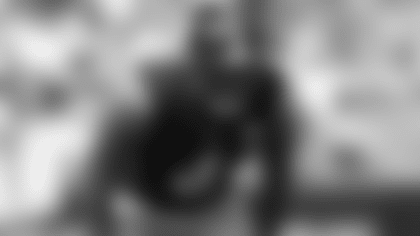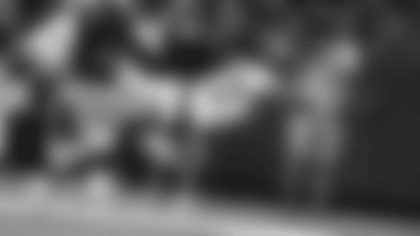Q. In situations where you have officials work practice in an effort to clean up the number and the kind of penalties, where do the officials come from, and what are you looking for from those officials?
A. They're local college and high school officials. It's just good work for them. Some of those guys aspire to ascend, and part of their development is the speed of the game. They get a chance to work, and so it's good for all parties involved. Their presence just adds physical work to an agenda. I stand in front of the group and say we need to clean the penalties up, so how do we go about it? We intensify our standard of expectations in a practice by having officials and having them throw flags when appropriate, and most importantly, the dialogue after the play of why and what was the trigger in terms of creating the penalty. It's all done in an effort to kick our own butts less, because part of being a tough team to beat is not beating yourself.
Q. Is it anything like the period of training camp when NFL officials visit Saint Vincent College for a few days?
A. No question. The minute we put the pads on, I always want officials there because it's just such a significant component of carrying pads. And so it's highly emphasized at the early stages of the journey when we're no longer playing football in shorts, because I want people to play clean. There's a competitive component to padded football that still needs to be clean, so we emphasize that at that point in the journey, and then we re-introduce them at points in the journey where needed like we are right now, because we're not getting the results that we desire.
Q. When the team is having an issue with penalties, is the message to the players simply along the lines of "cut that out," or is there a more nuanced teaching that happens, for example, in terms of what a defensive back or an offensive lineman can do with his hands to avoid a flag vs. what's more likely to draw a flag?
A. It's both. If you're trying to get better at something you better drop multiple lines in the water. In some instances, it requires a "Hey, cut that out." In other instances it requires technical teaching and a focus on fundamentals. And so we don't just subscribe to one mode of operation. We're going to drop as many lines in the water as necessary to get the desired result.
Q. How did the decision to have Joey Porter Jr. follow DeAndre Hopkins come about?
A. Joey asked for it, and for me, particularly on an assignment like that, that's where it starts. If I'm asking them it's not as authentic, you know what I mean? Ike Taylor used to ask for such matchups routinely. I like doing business with guys who have that mentality, and so it didn't take me long to ponder it. I just wanted to make sure that it was beneficial for him and for us in doing so, and it was.
Q. What specific skill-set does a cornerback need that would allow that tactic to have a chance at being a success?
A. It's a mind-set more than a skill-set, to be quite honest with you. It's a down-in-and-down-out competition. It gets really personal, and it doesn't take long once the receiver realizes that you're waiting for him to break the huddle and you're going in a certain direction. It gets personal really quickly. And so it's similar in basketball when somebody's trying to minimize a high scorer. It gets personal really quickly. More than a physical skill-set, it better be a demeanor, it better be a mind-set, because it's going to be an all day job.
Q. How would you evaluate James Daniels since he was signed as an unrestricted free agent, and what does his individual skill-set bring to the offensive line as a unit?
A. He's been really solid. He's a good above-the-neck player. He works great in concert with others, which helps in two-man games in pass protection. He's a really solid run blocker. He's got built-in leverage. He's not an overly tall guy, and I think that shows up consistently in a positive way in his run-game blocking in terms of getting under people and winning that component of play. Obviously, he dealt with an injury a number of weeks back and that kind of slowed the fluidity of this journey. But in general, it's been arrow pointed up.
Q. How is a right guard different than a left guard in terms of what a team is looking for from a player in those respective spots?
A. It really just depends on the tandem. The guy who's better equipped to be in one-on-one circumstances, you put them in more one-on-one circumstances. It has nothing really to do with the direction. David DeCastro played right guard, and he was an All-Pro caliber player. Our center went left and there were more double-teams to the side with Ramon Foster at guard. No disrespect to Ramon Foster, but David DeCastro was a first-round pick and a Pro Bowl-caliber player, and so we isolated him more. We pulled him more. It has nothing really to do with right or left. It's about the tandem and who you want to ask to do what.
Q. As an example, NFL edge rushers often are defensive ends in college, so in terms of the pipeline from college football to the NFL, where are today's every-down inside linebackers coming from when it comes to their football background in college?
A. They played inside linebacker. Maybe some of them are oversized safeties in high school who are super athletic and they develop into those athletic guys, but I think inside linebacker is a position and those guys have been playing that position generally all their lives. Every now and then you'll get an oversized safety, who at 17 years old thinks he's a safety but at 21 years old he realizes he's a linebacker. Thomas Davis, for example, was an All-American safety at Georgia. I told him he was a linebacker going into the NFL draft the year he came out. I didn't know if he liked hearing it, but I just wanted to tell him the truth. Obviously, he was a linebacker. He played a long time at a high level at inside linebacker. But generally those guys play inside linebacker in Little League and stay there.
Q. When it comes to projecting defensive players from college to the NFL, is inside linebacker becoming the most difficult?
A. No, I don't think so. I really don't. Again, you mentioned the edge rusher as an example. People don't edge rush in high school because there's not enough one-dimensional drop-back passing for them to impact the game, and so those guys usually discover that they're edge rushers in college. Top-flight cornerbacks play free safety in high school, because if they played cornerback, people would just throw the ball away from them. And so, people generally find their home positions in college, to be quite honest with you. There's the hybrid component of who's a 4-3 end vs. who's an outside linebacker and that mesh, but generally you find your home position transitioning from high school to college and not college to pro.
Q. Rich Bisaccia is Green Bay's assistant head coach/special teams, and you worked with him when you were both assistants in Tampa in the early 2000s. He's now recognized as one of the top special teams strategists in the NFL. Does he have a signature, or a characteristic that's unique to him or his units?
A. Let's not start complimenting Bisaccia (laughs). No, I love him. He's got really good leadership skills. He's an awesome communicator. And I think that's what's really required in that space. He's bringing guys together from two different sides of the ball. There's some fluidity in that space, and his natural leadership skills, his communication skills, his ability to build rapport with people is a winning edge for him in that space. I worked with him for a number of years, and that's what I think about when I think about him.
Q. Does Danny Smith and his group have to be more on guard for fakes or other gadgets when going against a guy with Bisaccia's track record?
A. Danny Smith is one of those guys that people watch out for, too, and so I'm sure they'll cancel each other out in some form or fashion today. Little known fact: Those guys vacation in the Carolinas together during the summer. Their relationship probably runs deeper than mine with Richie, and so you know there'll be trying to trick each other.
Q. What do you remember about Jordan Love from your draft prep back in 2021?
A. To be honest with you, I don't remember a lot at all. We were kind of window shoppers and not real shoppers (for quarterbacks) yet at that time. Obviously, I saw the talent and so forth, but I didn't do the type of leg work that would make you as comfortable with the intangible things that kind of define that position as I was well-versed, say with Kenny Pickett's class the following year.
Q. Q. How would you describe Jordan Love as a player now that you've had a chance to watch him in preparation for today's game?
A. His mobility is more than I anticipated, and so there are some things to deal with there schematically, but I don't know that that's new. I always thought Aaron Rodgers' mobility was underrated, and the Packers utilized that, they weaponized that. Obviously, Aaron's passing talent was so strong that you slept on that other aspect, and so there's some mobility things to be concerned about. (Love) has got arm talent; he can make any throw on the field. You see that, but the mobility component is the thing that always captures your attention the first time you're in a stadium with somebody because looking at it on video is different than feeling it in-game. And so we can't have this guy break out and convert a third-and-8 with his legs before we recognize that is a legitimate threat, because we've lost a possession down, for example. We can't have this guy break contain on a bootleg and run down the sideline for 20 yards because that's a field-flipping play. And so I don't want to see our group warm up to his mobility component of play. We've got to believe what we see on tape.
Q. Buffalo's Josh Allen is a notable example of this, or maybe he's a notable exception, but generally speaking is accuracy a skill that can be taught and refined once a college quarterback comes to the NFL?
A. I think there's a window in their first NFL contract where all guys improve in that area. Some guys (improve) more than others. But if you looked at anybody who's had a lengthy career in the National Football League at that position, you see growth over the first 1-to-4 years in terms of that statistic.
Q. I know you love your job, and I imagine there are things about it that are fun for you. What's fun about coaching this particular team as it navigates this particular journey?
A. They've quickly shown that they're not scared of big moments. And let's be honest, all teams don't run to big moments. This group seems to have a collection of guys who want to make the splash play at the critical time. We've been in some tight ballgames, and I don't feel fear. I feel guys who are playing to win in the weighty moments or in the waning moments of games. And that's fun to be around.
Q. Can you nurture that, or do they have to come to you already with it?
A. I've worked my tail off to nurture it in terms of the situations that I put him in, and how transparent we are about competition and so forth. But you know, that's a God-given thing from an individual perspective – that desire to compete, that strong will we look for in the acquisition of players because we just realize how important it is.
Q. In terms of defensive strategy in a game where you want to double one of the opponent's wide receivers, what things – be it alignments, formations, etc. – would make that difficult?
A. At this level, given a full week to prepare, if we want to put two people on somebody, we're gonna get two people on him. And not just us, but everybody. That's just kind of where the game is today. Fifteen years ago, I could talk about motions and moving a guy and trying to hide a guy with structure and it being somewhat competitive, somewhat challenging, but the game has evolved to that point. These guys have been doubling and identifying dangerous people since high school. It's just kind of the schematic evolution of the game. It's very difficult to hide a guy if people want to put two people on him.














